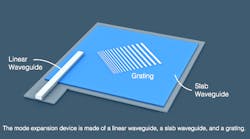NIST waveguide-to-free-space converter produces wide collimated beam for gas sensing (see video)
Researchers at the National Institute of Standards and Technology (NIST; Gaithersburg, MD), the University of Maryland, (College Park, MD), and Texas Tech University (Lubbock, TX) have created an optical waveguide-to-free-space coupler that converts a waveguide fundamental mode to a collimated free-space Gaussian beam with a 160 µm waist.1 The component, which can be part of an integrated photonics circuit, can be used to couple light into as well as out of a photonic circuit. Thus, it can take light in a waveguide, couple it out into a gas-filled environment, then back into the circuit (using a second coupler)—a configuration valuable for photonic-circuit-based gas sensors. In the device, light from a 300 × 250 nm silicon nitride high-index single-mode waveguide is first coupled into a slab waveguide to expand it in one dimension; the light then strikes a grating couple to expand it in a second dimension and couple it to free space (see video).
(Video: NIST)
The researchers demonstrated outcoupling of light from a waveguide into free space, propagation over 4 mm in free space, then coupling back into a waveguide.
The test device was designed for use at a 780 nm wavelength, but could be designed for telecom or visible wavelengths, say the researchers.
Source: https://www.nist.gov/news-events/news/2018/11/new-device-widens-light-beams-400-times-broadening-possibilities-science
REFERENCE:
1. Sangsik Kim et al., Light: Science and Applications (2018); doi: 10.1038/s41377-018-0073-2.
About the Author
John Wallace
Senior Technical Editor (1998-2022)
John Wallace was with Laser Focus World for nearly 25 years, retiring in late June 2022. He obtained a bachelor's degree in mechanical engineering and physics at Rutgers University and a master's in optical engineering at the University of Rochester. Before becoming an editor, John worked as an engineer at RCA, Exxon, Eastman Kodak, and GCA Corporation.

